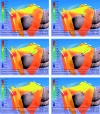An overview of recent applications of computational modelling in neonatology
- PMID: 20439275
- PMCID: PMC2944385
- DOI: 10.1098/rsta.2010.0052
An overview of recent applications of computational modelling in neonatology
Abstract
This paper reviews some of our recent applications of computational fluid dynamics (CFD) to model heat and mass transfer problems in neonatology and investigates the major heat and mass-transfer mechanisms taking place in medical devices, such as incubators, radiant warmers and oxygen hoods. It is shown that CFD simulations are very flexible tools that can take into account all modes of heat transfer in assisting neonatal care and improving the design of medical devices.
Figures




Similar articles
-
Modelling of heat and mass transfer processes in neonatology.Biomed Mater. 2008 Sep;3(3):034113. doi: 10.1088/1748-6041/3/3/034113. Epub 2008 Aug 15. Biomed Mater. 2008. PMID: 18708705 Review.
-
A combined study of heat and mass transfer in an infant incubator with an overhead screen.Med Eng Phys. 2007 Jun;29(5):531-41. doi: 10.1016/j.medengphy.2006.07.011. Epub 2006 Oct 9. Med Eng Phys. 2007. PMID: 17030142
-
Thermoregulation: incubators, radiant warmers, artificial skins, and body hoods.Clin Perinatol. 1991 Sep;18(3):403-22. Clin Perinatol. 1991. PMID: 1934849 Review.
-
Heat and mass transfer under an infant radiant warmer--development of a numerical model.Med Eng Phys. 2010 Jun;32(5):497-504. doi: 10.1016/j.medengphy.2010.02.021. Epub 2010 Mar 31. Med Eng Phys. 2010. PMID: 20356778
-
Infant incubators and radiant warmers.Early Hum Dev. 1983 Oct;8(3-4):351-75. doi: 10.1016/0378-3782(83)90018-x. Early Hum Dev. 1983. PMID: 6641579
Cited by
-
Specific absorption rate and temperature in neonate models resulting from exposure to a 7T head coil.Magn Reson Med. 2021 Sep;86(3):1299-1313. doi: 10.1002/mrm.28784. Epub 2021 Apr 3. Magn Reson Med. 2021. PMID: 33811667 Free PMC article.
References
-
- Bolton D. P. G., Nelson E. A. S., Taylor B. J., Weatherall I. L. Thermal balance in infants. J. Appl. Physiol. 1996;80:2234–2242. - PubMed
Publication types
MeSH terms
LinkOut - more resources
Full Text Sources
Miscellaneous

